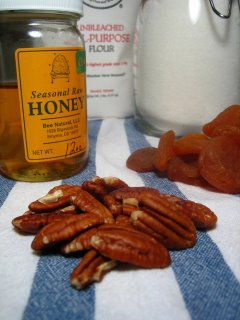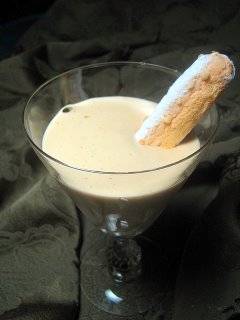
We're woefully overdue for another Sunday night sweets entry. It isn't that I haven't been baking; it's just that life has been interfering with blogging time again. The hazelnut chocolate chip cookies I made two weeks ago were a bit disappointing and not worth posting about yet, but I'll try to find time to write up last week's almond-caramel sandwich cookies sometime soon, since they came out rather well.
In the meantime, tonight's mood was in the cake direction. The foibles of my crappy oven aside, I've been really happy since I started using Shirley Corriher's recipe for Basic Moist Sweet Cake from Cookwise for cupcakes. The method is a bit quirky, since you blend the flour and the fat together first, then add the liquid ingredients, but the end product is wonderfully moist, tender, and velvety. I think it might actually work better as cupcakes, since the crumb is so delicate and melting that I can't imagine it holding up particularly well to frosting or slicing as a full-sized cake. As it is, you really need to double-line the muffin cups, or use the stiff mini-panettone molds I used this time, to give the cakes enough support to stand up once you unmold them; otherwise, they just spread and deform in the liners.
Besides the fantastic texture, the other advantage of this recipe is that you can use any oil you like, but nut oils, if you have them, give you an incredibly flavorful end product. Nearly every time I've made this recipe, I've used macadamia oil, which gives the basic yellow cake a wonderfully exotic, round, full flavor. This time, since I'm out of the macadamia, I used hazelnut, which inspired me to go with the coffee-chocolate combination of the classic Opera Cake when it came time to frost. Having both a coffee buttercream and a ganache glaze is probably overkill for cupcakes, but I couldn't decide on one or the other, and I really do love the combination of chocolate, coffee, and nuts.
I'm not entirely happy with the decoration here, because the coffee beans are too small and too dark to make any impact against the ganache. Next time I'd probably use the half-cup of leftover buttercream to pipe rosettes on top of the ganache and then top with the coffee bean, or perhaps a chocolate-covered espresso bean. I'm not going to knock myself out over aesthetics this late on a Sunday, though, and anyway, you really can't argue with the taste.
Opera Cupcakes
Makes 20-24 cupcakesHazelnut Cakes
2 large eggs
3 large egg yolks
6 tablespoons plus 2 tablespoons buttermilk (1/2 cup total)
1 teaspoon vanilla extract
1 1/2 cups cake flour
1 1/3 cups granulated sugar
1 1/2 teaspoons baking powder
1/2 teaspoon salt
1/4 pound (1 stick) unsalted butter
1/3 cup hazelnut oil (or other nut oil, or mild vegetable oil)
Leave eggs, buttermilk and butter out at room temperature until butter has softened.
Place shelf in lower third of oven, and preheat to 350. Set 20 mini panettone molds on a baking sheet, or line two muffin trays with liners.
Sir the eggs, yolks, 6 tablespoons buttermilk and vanilla together in a liquid measuring cup.
In the bowl of a standing mixer, combine the flour, sugar, baking powder and salt, and mix on low speed for 30 seconds. Add the butter, oil and remaining 2 tablespoons butermilk, and mix on low until the dry ingredients are moistened. Increase to medium and beat for 1 1/2 minutes, until light. Add the liquid ingredients, one third at a time, beating for 20 seconds between additions.
Fill the molds or muffin cups halfway and bake until golden and a tester comes out clean,
approximately 20-25 minutes. Remove from oven and let sit on baking sheet or in muffin trays for ten minutes before removing to a cooling rack to cool completely.
Coffee Buttercream
3 cups powdered sugar
1 cup (2 sticks) butter
1 teaspoon vanilla extract
2 tablespoons instant espresso powder, dissolved in 1/4 cup hot water
1 to 2 tablespoons whipping cream
In a standing mixer, mix the sugar and butter on low speed until well blended, then increase speed to medium and beat for another 3 minutes, until light and fluffy.
Add vanilla, dissolved espresso and cream and continue to beat on medium speed for 1 minute more, adding more cream if needed for spreading consistency.
Once the cupcakes have completely cooled, spread 2-3 tablespoons of buttercream over the cakes, creating as smooth and level a surface as possible and leaving at least 1/4 inch of space between the buttercream and the top of the mold/liner for the ganache layer. Refrigerate the frosted cupcakes in an airtight container until the buttercream has firmed.
Ganache
150 grams heavy cream
150 grams dark chocolate, chopped fine
2 tablespoons Lyle's Golden Syrup (or corn syrup)
Heat the cream in a liquid measuring cup in a microwave until near boiling, approximately 1-2 minutes. Add the chocolate and whisk thoroughly, until chocolate has dissolved and the mixture is smooth. Whisk in the syrup.
Pour 1-2 tablespoons of the ganache over the frosted cupcakes, tilting the cupcakes to swirl the ganache over the surface and ensure even coverage of the buttercream layer. (Do not touch the ganache or try to spread it with a spatula or other utensil, as it will mar the shiny surface of the end product.) If desired, add a coffee bean or chocolate covered espresso bean as garnish.
Return to the refrigerator in a covered container until the ganache has set.







